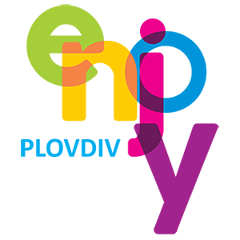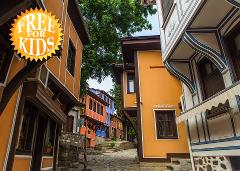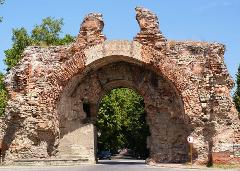The Treasures of Plovdiv's Roman Heritage

- Duração: 5 Horas (Aproximadamente)
- Localização: Plovdiv
- Código de produto: PLDROME
About
Experience Plovdiv as an ancient Roman. A full-day tour of the ancient city of Plovdiv - the oldest and most glorious capital of Thrace. Understanding the history of the city over 8 millennia. Immersion in the lifestyle, culture and customs of the ancient Thracians, Greeks and Romans.
Discover the mysteries of religious feasts and rituals. Find out where the ancient athletes competed and the gladiators fought to death. Plovdiv is the largest open-air museum in Bulgaria, preserved in unique form of unique buildings and facilities for more than two thousand years.
Highlights
• See the most famous sights of Plovdiv - the Ancient Theater (1 st century BC) - one of the best preserved in the world, and the Roman Stadium (II century after Christ).
• Tour of the defensive walls, fortresses and entrances of the ancient city - Hissar Kapia, Nebet tepe and the East Gate.
• Explore the most interesting artifacts - the Panagyurishte treasure, the ancient synagogue of the III century after Christ, Roman parade slimming 2 million, an ancient mosaic with Narcissus.
• Get to know Philipopolis's life - the Forum, the main public buildings, markets and statues of gods and emperors.
Description
One of the most ancient cities in the world and Europe - Plovdiv, today, among its stunning landmarks, are the Antique Theater and the Roman Stadium, built almost two millennia ago. At today's center, the Forum (Agora), where the public buildings of the ancient Philippopolis were housed, was partially discovered.
Even the shortest walk through the city of the Seven Hills inevitably becomes a jump through a time machine in the good old days of the Thracians, the Greeks and the Romans. A lot of water has leaked past the hills since Philip Macedonian, but some things remain the same.
Today, and twenty centuries ago, Plovdiv celebrated its largest holiday on the same date - September 6th. In ancient times, the feast was dedicated to the chief city god Apollo (bearing also the Thracian name Kendrissos), whose temple was located on Dzhendem Tepe. Today, on 6 September, we celebrate the Unification of the Principality of Bulgaria with Eastern Rumelia, which took place in 1885.
And in antiquity, and nowadays on the top of Bunardzhika a monument of a warrior - a statue of Heracles in the past, and today - a monument of the Soviet soldier Alyosha. At the foot of the Clock Tower, the sixteenth century of Sahat Tepe in Antiquity has counted the city's great water clock. Our adventure will begin at the Archaeological Museum, which keeps a rich collection of over 100,000 artifacts.
The most famous is the Panagyurishte gold treasure belonged to a Thracian ruler from the end of the 4th and the beginning of the 3rd century BC. The nine gold objects - one phial and eight rhytons, with a total weight of over 6 kg, were used in religious ceremonies.
In a totally preserved form, the early-Christian tomb of the 3rd century was introduced into the sensation. On the walls Christ is painted as a magician, he performs miracles with the help of a magic stick - revives Lazar and heals the paralyzed man. Similar rare frescoes are also preserved in the catacombs of Rome during the early Christian period. Later the waving of a magic wand falls out of the canon.
In the halls of the museum can be seen another good find - a Roman parade helmet made of iron and bronze at the end of I or the beginning of the 2nd century AD. Only three similar masks are preserved in the world - the other two are in Germany and France.
Experts estimate its market value at EUR 2 million. The prestige of the valuable exhibit continued even today - in 1995, the helmet was stolen from the museum but subsequently found and restored. They returned him to his place in 21 years. We will see the Roman mosaic with Narcissus. The masterly crafted panel features a myth about the hero who falls in love with his own image. (A reminder of narcissistic natures - in the original Greek myth, Narcissus does not realize that he falls in love with himself, he is fascinated by the image of the wonderful stranger he sees in the water.) In the four corners of the mosaic dating from the beginning of the 3rd century are depicted dolphins.
A rich and cosmopolitan city, the ancient Philippopolis has remained the only ancient synagogue in Bulgaria. The Jewish temple was built at the beginning of the third century AD and was in operation until the end of the 6th century when it was destroyed, probably during the anti-Jewish persecution of Emperor Arkady. From the Jewish temple is partially preserved the floor mosaic with a seven-person (menorah).
Once we are satisfied with the treasures of the Archaeological Museum, we head to the Little Main Street, where the craft-shop was once located. We make sure we do not get lost in one of the fashion boutiques and do not get bogged down with some of the sweet-hearted locals. The Roman stadium accommodated 30,000 spectators.
The road takes us to Djumayata Square, the heart of Plovdiv, from which nine streets are decorated with non-Baroque and Gothic buildings. Next to the great mosque we go down the stairs and walk through the ancient street to get to the stadium of the Roman stadium. The marble sports complex built in 120 AD. It is 240 meters long and is completely preserved underground.
If someone wants to destroy the dignified buildings of the Main Street (unimaginable sacrifice!), It could safely reveal the arena with stands for 30,000 viewers. Besides the northern part, elements of the stands are preserved in the dungeons of two shopping centers.
At the marble stadium in ancient Philippopolis, Pythian Games were organized periodically, similar to those around the sanctuary of Delphi, Greece. In honor of the visit of Emperor Karakalas in 214, the games were called Alexandrians, and during the Emperor Elagabal's visit in 218, they named them Kendrisi. The games were the biggest in Thrace, with athletes from all over the Empire.
Two-day championship held pancreatic competitions (martial arts - a combination of boxing and wrestling); pentathlon (penboy), which included a jump in length, spear and disk throw, sprint, wrestling, boxing and jogging. There were also races for poets, singers, trumps and trumpets.
The races between trumpets and trumps were the only ones judged by judges. The winners of the games received a laurel wreath, a palm branch, apples, a spherical crown, a pouch with vases, and a bowl of olive oil.
The marble seats of the first people of Philippopolis still feature their inscriptions, coats of arms and ornaments. For a moment you can sit in the place of one of them, if you consider it very important - step into the imperial lodge over the entrance.
In the Ancient Theater, the Parliament met, gladiators fought.
The next stop of our Roman adventure is the Antique Theater - the pearl of the crown of Philippopolis, which is today a favorite scene of a number of world music stars. The marble pearl has been in oblivion for 15 centuries before archeologists accidentally encountered it in 1968.
The theater was built in the 90's after Christ by the mayor of Titus Flavius Kotys, the descendant of the Thracian royal dynasty of the Odrys. It is made of white marble with pink veins, brought from the Rhodopes. It has 28 rows of seats with about 5000 seats.
Each Philipopolis fillet has its own seating area. The Philes had their leaders and were dedicated to gods, heroes and kings - the Orpheus, Eumolipid, Philippi, Dionysias, Artemisias, Hebrew, Rhodopes and others. Theatrical performances were performed at the Ancient Theater, and the coin - the general assembly of the representatives of all the towns in the province of Thrace - was also sitting here. There are also poetry and dramatic competitions from the Pythian Games. In the marble arena were held the feasts and rituals of the imperial cult, which the coinnon was responsible for.
One of the intriguing puzzles of ancient Philippopolis is where the most popular show of the era - gladiatorial struggles - was held. Historians believe it is most likely that battles took place at the Ancient Theater, where traces of protective devices were found to protect the audience in wild beast battles. There is also a possibility that the battles of death with predators and people have become in the undetected arena, which should be a large and representative amphitheater.
A number of proofs have been found about the popularity of the spectacle - gladiator games, memorial tablets, and gladiator dedications. One of the stone ads depicts struggles with panther and bull. The names of several winners of the struggles, which have received great honors and generous wages, are also known.
We leave behind the Ancient Theater and continue on the main street of the Old Town. The weather is convenient for a short lunch and refreshing drinks - restaurant "Vazrazhdane" or "Rahat tepe"? At the cobblestone we reach another of the symbols of Plovdiv - Hissar Kapia. Originally, this gateway to the fortress was erected by Emperor Mark Aurelius in 172 AD, when the great fortress wall around the ancient city was built. Its current city door was built in the 11th-13th century. A fortress wall and southern round tower are preserved around the gate.
The ancient city was defended by Nebet Tepe, which is our next stop. From here there is an amazing panorama to the entire city. Originally the fortress was built by the Thracian rulers in VI-V century BC. It was built by Philip of Macedon. Later, Philip III Ariide, brother of Alexander of Macedon, built a tower with soldiers at the top of the hill.
Nearly 1,000 years ago the fortress walls of the Three Hills were built and destroyed, then built again. In 250, the Goths defeated them, in 441 - the Huns of Attila. The walls remembered the invasions of the Avars in 587 and the Kiev prince Svetoslav in 970. The defensive facility of Plovdiv was used until the fall of the city under the Ottoman Empire. During the Revival Bulgarian, Greek and Armenian merchants built their beautiful houses in the immediate vicinity or directly on the fortress wall, using the big stones as the basis.
At the foot of the Old Town we are waiting for the Eastern Gate - the main entrance of the city, where the Emperors met. From here was the road connecting Rome to the Bosphorus and, since the 4th century AD, the capital of the Eastern Roman Empire, Constantinople. The street was 13 meters wide and, on both sides, there were richly decorated colonnades. Here is the first marble Arch of Triumph in Bulgaria.
The last landmark of our Roman adventure is the Forum (Agora), where important commercial, religious and public buildings were located. Interestingly, today's central streets and squares of Plovdiv are just the same as those of the Roman epoch.
The Forum began to be built in the middle of the 1st century AD by the last Thracian ruler Remetalk, when Thrace was conquered by Emperor Augustus. Among the buildings studied were the Odeon-Polyphterum, the City Library and the Treasure Building.
Odeon met the City Council of Philippopolis. He was surrounded by a large market, and in the northern part were the imperial statues. A great monument of Orpheus, the greatest Thracian poet and a musician of antiquity. For the last part of our tour for the day we will pay Special attention to the three antique buildings with Roman mosaics, with which Plovdiv is applying for entry in the UNESCO World Heritage List. In the Little Basilica (V century) is preserved the stone baptistery - a baptismal buckle, decorated with ancient Christian symbols - a deer that drinks water and two pigeons. After a massive restoration of the Roman mosaics, the church was open to visitors in 2013. The grand basilica of the 4th century, whose opening is due in the beginning of 2019, impresses with large mosaics.
The most interesting are the 100 birds of paradise, among which the peacock shines brightly. The bird with a dazzling tail is an old symbol of royal power, Christ also embodies. Since the middle of the third century the magnificent house Eirene, belonging to the rich family of Plovdiv, has been preserved. The Roman mosaics are preserved in the Trakart cultural center, where many exhibits of the heritage of the Thracians, Greeks and Romans can be seen. At the center of the composition is the ancient Greek goddess of Peace Eirene - a testimony of the time when pagan and Christian images coexisted in the city of the seven hills.
Here ends our tour - you can jump out of the shoes of an ancient Roman and continue your way as a modern citizen of Plovdiv.
Price per person
• For a group of 6 or more: 20 €
• For a group of 2-5: 25 €
• For a single tourist: 40 €
• Free for kids under 16
The price includes
• Tour guide
The price does not include
• Entrance fees
Notes
Visitors are advised to wear comfortable shoes – the tour involves walking through the cobbled streets of the Old Town.







